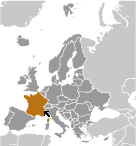World Atlas: France. On this page you can see the map, country flag and many detailed information about the people, history and economy of France.

Here you can find online selected information about the geography, inhabitants, government, economy and history of France. Included are selected statistics, an overview map and the detailed map of France. But let's start with the flag of France here:
France - Overview:
What you should know about France? Let's start with this: France today is one of the most modern countries in the world and is a leader among European nations. It plays an influential global role as a permanent member of the United Nations Security Council, NATO, the G-7, the G-20, the EU, and other multilateral organizations. France rejoined NATO's integrated military command structure in 2009, reversing DE Gaulle's 1966 decision to withdraw French forces from NATO. Since 1958, it has constructed a hybrid presidential-parliamentary governing system resistant to the instabilities experienced in earlier, more purely parliamentary administrations. In recent decades, its reconciliation and cooperation with Germany have proved central to the economic integration of Europe, including the introduction of a common currency, the euro, in January 1999. In the early 21st century, five French overseas entities - French Guiana, Guadeloupe, Martinique, Mayotte, and Reunion - became French regions and were made part of France proper.
Geography of France
 Where on the globe is France? The location of this country is Western Europe, bordering the Bay of Biscay and English Channel, between Belgium and Spain, southeast of the UK; bordering the Mediterranean Sea, between Italy and Spain. Total area of France is 643,801 sq km; 551,500 sq km (metropolitan France), of which 640,427 sq km; 549,970 sq km (metropolitan France) is land. So this is quite a large country. How could we describe the terrain of the country? This way: mostly flat plains or gently rolling hills in north and west; remainder is mountainous, especially Pyrenees in south, Alps in east. The lowest point of France is Rhone River delta -2 m, the highest point Mont Blanc 4,810 m. And the climate is generally cool winters and mild summers, but mild winters and hot summers along the Mediterranean; occasional strong, cold, dry, north-to-northwesterly wind known as mistral.
Where on the globe is France? The location of this country is Western Europe, bordering the Bay of Biscay and English Channel, between Belgium and Spain, southeast of the UK; bordering the Mediterranean Sea, between Italy and Spain. Total area of France is 643,801 sq km; 551,500 sq km (metropolitan France), of which 640,427 sq km; 549,970 sq km (metropolitan France) is land. So this is quite a large country. How could we describe the terrain of the country? This way: mostly flat plains or gently rolling hills in north and west; remainder is mountainous, especially Pyrenees in south, Alps in east. The lowest point of France is Rhone River delta -2 m, the highest point Mont Blanc 4,810 m. And the climate is generally cool winters and mild summers, but mild winters and hot summers along the Mediterranean; occasional strong, cold, dry, north-to-northwesterly wind known as mistral.
Inhabitants of France
Let's take a look how many people live in France. The number is: 67,106,161. So quite a lot people live here. Who lives here? Celtic and Latin with Teutonic, Slavic, North African, Indochinese, Basque minorities. What are the languages in France? French (official) 100%, declining regional dialects and languages (Provencal, Breton, Alsatian, Corsican, Catalan, Basque, Flemish, Occitan, Picard). And the religions: Christian (overwhelmingly Roman Catholic) 63-66%, Muslim 7-9%, Buddhist 0.5-0.75%, Jewish 0.5-0.75%, other 0.5-1.0%, none 23-28%. How old are the people in average? 41.4 years. We have to add that this number is the median - so one half of the people is older than this, one half is younger. And what is their life expectancy (at birth)? This: 81.9 years. Where the people live in France? Here: much of the population is concentrated in the north and southeast; although there are many urban agglomerations throughout the country, Paris is by far the largest city, with Lyon ranked a distant second. The major urban areas of France are: Paris (capital) 10.843 million; Lyon 1.609 million; Marseille-Aix-en-Provence 1.605 million; Lille 1.027 million; Nice-Cannes 967,000; Toulouse 938,000 (2015).
Government and Economy of France
The capital of France is Paris and the government type semi-presidential republic. Let's take a look at the administrative divisions - 18 regions (regions, singular - region); Auvergne-Rhone-Alpes, Bourgogne-Franche-Comte (Burgundy-Free County), Bretagne (Brittany), Centre-Val de Loire (Center-Loire Valley), Corse (Corsica), Grand Est (Grand East), Guadeloupe, Guyane (French Guiana), Hauts-de-France (Upper France), Ile-de-France, Martinique, Mayotte, Normandie (Normandy), Nouvelle-Aquitaine (New Aquitaine), Occitanie (Occitania), Pays de la Loire (Lands of the Loire), Provence-Alpes-Cote d'Azur, Reunion. Regarding the economy of France, important industrial products are machinery, chemicals, automobiles, metallurgy, aircraft, electronics; textiles, food processing; tourism. Important agricultural products are wheat, cereals, sugar beets, potatoes, wine grapes; beef, dairy products; fish. The most important export commodities are machinery and transportation equipment, aircraft, plastics, chemicals, pharmaceutical products, iron and steel, beverages and the most important export partners are Germany 16%, Spain 7.6%, US 7.3%, Italy 7.2%, UK 7%, Belgium 6.8% (2016). The most important import commodities are machinery and equipment, vehicles, crude oil, aircraft, plastics, chemicals and the most important import partners are Germany 19.3%, Belgium 10.6%, Netherlands 7.9%, Italy 7.8%, Spain 7%, US 5.8%, China 5.1%, UK 4.2% (2016). How rich is France and how rich are people in this country? The most important number here is GDP per capita (PPP): $43,600 (2017 est.). This means the people are rich on average here. Let's add that this means Gross Domestic Product per person, which is recalculated with respect to the relative cost of local goods and services. And one more important number - population below poverty line: 14% (2013 est.).